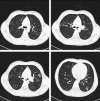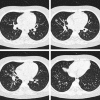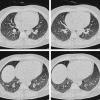Initial HRCT findings of novel influenza A (H1N1) infection
- PMID: 22551111
- PMCID: PMC4941708
- DOI: 10.1111/j.1750-2659.2012.00368.x
Initial HRCT findings of novel influenza A (H1N1) infection
Abstract
Objectives: The aim of our study was to describe the presentation and illustrate the imaging features of chest high-resolution computed tomography (HRCT) of patients with novel influenza A (H1N1) virus infection.
Methods: Data were collected from 163 hospitalized patients between November 2009 and March 2011, who fulfilled the clinical criteria for H1N1 influenza infection and underwent HRCT examinations within 24 hours of admission.
Results: Abnormal findings were observed in 40.5% of the patients. The patients with positive imaging findings were significantly older than patients with normal HRCT findings (P=0.02). The most common finding was ground-glass opacity (GGO) (n=35). Interlobular septal thickening (n=31) and centrilobular nodules (n=30) were the second most frequent findings. Other common findings were consolidation, reticulation, and linear shadow. The most common imaging finding for lung involvement was GGO with a patchy pattern. Pulmonary involvement of the disease may be extensive and variable, but the total volume of affected lung was mostly <1 lobe.
Conclusion: The baseline HRCT may be valuable and suggestive even for non-severe H1N1 infections. When a severe case or a evolution is suspected, chest CT could be essential both for determining the precise extent of parenchymal damage and for monitoring its evolution.
© 2012 Blackwell Publishing Ltd.
Figures



Similar articles
-
High-resolution computed tomography findings of swine-origin influenza A (H1N1) virus (S-OIV) infection: comparison with scrub typhus.Acta Radiol. 2012 Jul;53(6):657-61. doi: 10.1258/ar.2012.120012. Epub 2012 May 27. Acta Radiol. 2012. PMID: 22637640
-
Chest radiography and CT findings in patients with the 2009 pandemic (H1N1) influenza.Diagn Interv Radiol. 2011 Sep;17(3):216-22. doi: 10.4261/1305-3825.DIR.3337-10.1. Epub 2010 Aug 12. Diagn Interv Radiol. 2011. PMID: 20703994
-
Pneumonia in novel swine-origin influenza A (H1N1) virus infection: high-resolution CT findings.Eur J Radiol. 2011 Nov;80(2):e146-52. doi: 10.1016/j.ejrad.2010.05.029. Epub 2010 Jun 20. Eur J Radiol. 2011. PMID: 20566254 Free PMC article.
-
Swine-origin influenza A (H1N1) viral infection: thoracic findings on CT.AJR Am J Roentgenol. 2011 Jun;196(6):W723-8. doi: 10.2214/AJR.10.5109. AJR Am J Roentgenol. 2011. PMID: 21606260 Review.
-
[What is it called? A formulation and glossary for the finding and understanding of results in HRCT of the lung].Rofo. 1996 Nov;165(5):428-37. doi: 10.1055/s-2007-1015785. Rofo. 1996. PMID: 8998313 Review. German.
Cited by
-
A deep learning-based quantitative computed tomography model for predicting the severity of COVID-19: a retrospective study of 196 patients.Ann Transl Med. 2021 Feb;9(3):216. doi: 10.21037/atm-20-2464. Ann Transl Med. 2021. PMID: 33708843 Free PMC article.
-
Evaluating antibody response pattern in asymptomatic virus infected pregnant females: Human well-being study.J King Saud Univ Sci. 2021 Jan;33(1):101255. doi: 10.1016/j.jksus.2020.101255. Epub 2020 Dec 2. J King Saud Univ Sci. 2021. PMID: 33288976 Free PMC article.
-
Radiological, epidemiological and clinical patterns of pulmonary viral infections.Eur J Radiol. 2021 Mar;136:109548. doi: 10.1016/j.ejrad.2021.109548. Epub 2021 Jan 14. Eur J Radiol. 2021. PMID: 33485125 Free PMC article. Review.
-
Longitudinal changes of pneumonia complicating novel influenza A (H1N1) by high-resolution computed tomography.Radiol Infect Dis. 2015 Jun;2(1):40-46. doi: 10.1016/j.jrid.2015.06.001. Epub 2015 Jun 9. Radiol Infect Dis. 2015. PMID: 32289066 Free PMC article.
-
Early chest CT features of patients with 2019 novel coronavirus (COVID-19) pneumonia: relationship to diagnosis and prognosis.Eur Radiol. 2020 Nov;30(11):6178-6185. doi: 10.1007/s00330-020-06978-4. Epub 2020 Jun 9. Eur Radiol. 2020. PMID: 32518987 Free PMC article.
References
-
- Centers for Disease Control and Prevention . 2008–2009 Influenza season week 32 ending August 15, 2009, http://www.cdcgov/flu/ weekly (Accessed 29 September 2009). World Health Organization. Pandemic(H1N1) 2009‐update 58. http://www.who.int/csr/ don/2009‐07‐06/en/index.html (Accessed 29 September 2009).
-
- Dawood FS, Jain S, Finelli L et al. Emergence of a novel swine‐origin influenza a (H1N1) virus in humans. N Engl J Med 2009; 360:2605–2615. - PubMed
-
- Perez‐Padilla R, de la Rosa‐Zamboni D, Ponce de Leon S et al. Pneumonia and respiratory failure from swine‐origin influenza A (H1N1) in Mexico. N Engl J Med 2009; 361:680–689. - PubMed
-
- Reittner P, Ward S, Heyneman L, Johkoh T, Müller NL. Pneumonia: high‐resolution CT findings in 114 patients. Eur Radiol 2003; 13:515–521. - PubMed
MeSH terms
LinkOut - more resources
Full Text Sources
Medical

